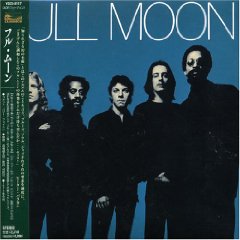After writing about Martha Velez’s 1968 release Fiends & Angels, I realized there are a number of albums that qualify as either era-defining or being highly influencial despite not having gained widespread recognition. These records weren’t huge sellers on first release but still made an impact, mostly with musicians, and all stand up today.
 The self-titled album Full Moon from 1971 fits into this category. Three of its members came from the Paul Butterfield Blues Band, drummer Phillip Wilson and tenor saxman Gene Dinwiddie (billed as Brother Gene Dinwiddie throughout the album’s credits), both of whom joined Butterfield around 1967 for The Resurrection Of Pigboy Crabshaw, and Buzz Feiten, who joined Butter a little later in ’68 replacing guitarist Elvin Bishop. Feiten, who did a stint with the Rascals after Butterfield, was one of the most unusual additions to Butterfield’s band, younger than most of the other players, precocious, almost punk for 1968. He brought a different sound and style and great versatility to the band with his piercing Fender Strat, cut more from a soul vein than blues.
The self-titled album Full Moon from 1971 fits into this category. Three of its members came from the Paul Butterfield Blues Band, drummer Phillip Wilson and tenor saxman Gene Dinwiddie (billed as Brother Gene Dinwiddie throughout the album’s credits), both of whom joined Butterfield around 1967 for The Resurrection Of Pigboy Crabshaw, and Buzz Feiten, who joined Butter a little later in ’68 replacing guitarist Elvin Bishop. Feiten, who did a stint with the Rascals after Butterfield, was one of the most unusual additions to Butterfield’s band, younger than most of the other players, precocious, almost punk for 1968. He brought a different sound and style and great versatility to the band with his piercing Fender Strat, cut more from a soul vein than blues.
They joined forces in 1971 with keyboardist Neil Larsen, from Florida, who later in the ’70s would record a string of exemplary jazz-fusion albums and also delve into pop rock with Feiten in 1980 as the Larsen-Feiten Band, and bassist Freddie Beckmeier. Over the years, Larsen and Feiten have also become legendary session players who have worked on hundreds of albums and with a who’s who of the music industry.
The resulting album, produced by Alan Douglas (yes, that Alan Douglas apparently, famous or perhaps infamous as onetime keeper of the Jimi Hendrix archive) was far from a blues-rock workout. It incorporated elements of soul, R&B and early jazz fusion built on strong songwriting from all members. Vocals were shared and more than capable and the playing a combination of forward-moving jazz, rock and soul with proficient and inspired soloing. Continue reading From the Vaults: Hidden Treasure, No. 2